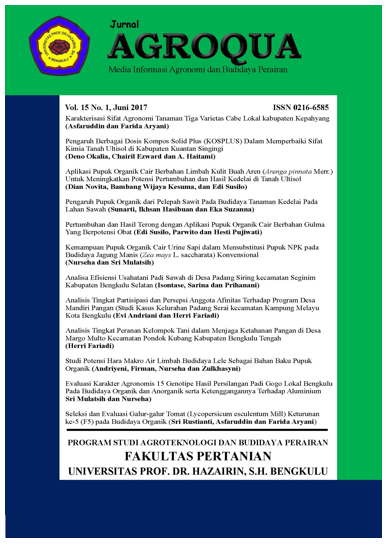PENGARUH DOSIS PUPUK PETROGANIK DENGAN SUMBER BENIH YANG BERBEDA TERHADAP PERTUMBUHAN DAN PRODUKSI BAWANG MERAH (Allium ascalonicum L.)
DOI:
https://doi.org/10.32663/ja.v21i1.3462Keywords:
Petroganic Dosage, Seed Source, Production, OnionAbstract
The study aimed to determine the effect of Petroganic fertilizer doses and seed sources on the growth and production of onion plants and to determine the interaction between the two. This study used 2 factorial shelves, petroganic (P) fertilizer dosage consisting of 4 levels, namely P0 = control, P1 = 10 gr/ polybag, P2 = 20 gr/polybag, P3 = 30 gr/ polybag, and different seed source factors consisting of 2 levels, namely B1 = seed TSS varieties Sanren F1 and B2 = seed tubers varieties Bima Brebes. Parameters observed were plant height, number of leaves, number of bulbs per clump, wet weight of bulbs per sample, and per plot. Petroganic fertilizer dose significantly affects plant height and number of leaves at the age of 40 and 60 HST, tuber weight per sample, and per plot. However, no real effect on plant height and number of leaves aged 20 HST, as well as the number of bulbs per clump. The best results were obtained in the P3 treatment. Treatment of seed sources significantly affected the plant height and number of leaves aged 40 and 60 HST, the number of tubers per clump, the wet weight of tubers per sample, and per plot. The best results were obtained in the B2 treatment. The interaction between the two had a significant effect on the parameters of the wet weight of tubers per plot. The best results were obtained in the combination of petroganic P3 fertilizer dosage treatment with B2 seed source.
References
Downloads
Published
Issue
Section
License
Authors who publish with this journal agree to the following terms:
- Authors grant the journal right of first publication with the work simultaneously licensed under a Creative Commons Attribution 4.0 Internasional (CC BY 4.0) Licence that allows others to use and share the work with an acknowledgment of the work's authorship and initial publication in this journal.
- The author(s) still hold the copyright of his/her/their work and retain publishing rights without restrictions such as (but not limited to) patent right, lecture, book and reproduce the article for own purposes.
















